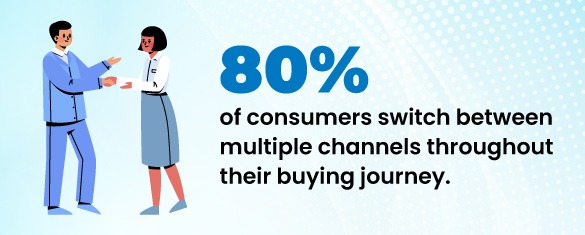Marketing is becoming increasingly complex, with rising costs and intensifying competition across every channel. In today’s landscape, running a successful campaign demands smarter strategies and close alignment across teams to generate leads, drive revenue, and ensure long-term business growth. This is where omnichannel marketing proves invaluable. A well-crafted omnichannel approach unifies sales, marketing, and customer support to deliver a seamless, consistent buyer experience that fosters trust and drives conversions. In this article, we’ll dive into the key principles of B2B omnichannel marketing, how it differs from multichannel tactics, and what it takes to design, implement, and optimize a strategy that meets the needs of today’s modern buyer.
What is B2B Omnichannel Marketing?
B2B omnichannel marketing is a customer-centric strategy that unifies all sales, marketing, and customer success channels to create a seamless and consistent brand experience. It integrates platforms such as email, social media, web, and advertising to engage prospects and customers wherever they are in their journey. By delivering personalized content and consistent messaging across touchpoints, B2B companies can guide decision-makers more effectively through complex buying processes. The goal is to meet target accounts on their preferred channels, enhance engagement, and drive better outcomes by aligning efforts across the entire go-to-market (GTM) team for a unified customer journey.
Omnichannel vs Multichannel Marketing:
Multichannel marketing uses multiple platforms like email, social media, and the web to reach customers, but each channel operates separately. Omnichannel marketing goes a step further by integrating all channels to create a consistent, personalized experience across the entire buyer journey. While multichannel focuses on channel-specific engagement, omnichannel ensures seamless interactions and unified messaging. The choice depends on your goals; multichannel offers reach, while omnichannel delivers deeper engagement and a cohesive customer experience.

Benefits of B2B Omnichannel Marketing:
Omnichannel marketing delivers numerous advantages for B2B companies. Here are some of the key benefits:
1. Enhanced Customer Experience
It lets customers engage with your brand across multiple platforms seamlessly. Personalization combined with this multi-touch approach improves customer loyalty and brand recognition. When customers receive consistent, relevant messaging regardless of channel, their overall satisfaction and trust in your brand increase significantly.
2. Increased Return Customer Rate & Sales
Retaining customers is more cost-effective than acquiring new ones. Omnichannel marketing enables targeted retargeting campaigns across channels, encouraging repeat purchases. By promoting relevant offers and services through integrated messaging, businesses can boost customer lifetime value and increase overall sales through consistent engagement.
3. Data-Driven Insights & Efficiency
Omnichannel strategies unify data from all customer touchpoints, offering a comprehensive view of what channels drive results. This insight allows marketers to optimize efforts, shift resources from underperforming channels, and focus on the most effective tactics, ultimately improving campaign performance and operational efficiency.
4. Stronger Brand Consistency
Delivering consistent messaging and brand experiences across channels builds trust and recognition. Omnichannel marketing ensures your brand voice, visuals, and offers remain uniform, whether customers interact via mobile apps, websites, or in-person. This consistency strengthens your brand identity and fosters long-term loyalty.
5. Expanded Engagement and Reach
With presence on multiple platforms, integrated marketing increases touchpoints where customers can interact with your brand. This diversified approach caters to varied preferences, whether social media, email, or direct contact, broadening your reach and maximizing opportunities to engage prospects and customers effectively.
Core Channels Driving B2B Omnichannel Success:
Digital, traditional, and emerging channels drive B2B omnichannel success by engaging prospects. Here are the key channels to build relationships and boost brand visibility across multiple touchpoints:
1. Digital Channels:
Digital channels are the backbone of modern B2B omnichannel marketing, providing scalable and measurable ways to engage prospects throughout the buyer journey. A company’s website, optimized for SEO, acts as the central hub, delivering rich content such as product information, case studies, and blogs tailored to buyers’ needs. Good website UX, fast loading, mobile-friendly, intuitive navigation, and integrated lead capture tools like forms and chatbots boost engagement and conversions. SEO ensures the right audience finds the site by targeting relevant keywords and leveraging content marketing to build authority.
Email marketing remains vital for personalized, direct communication. Segmented lists and automated drip campaigns nurture leads efficiently, while analytics help refine messaging. Social media platforms, especially LinkedIn and Twitter, amplify brand awareness and networking, enabling targeted advertising and real-time engagement. These digital channels together create a cohesive and interactive experience that supports the sales funnel and builds lasting customer relationships.
2. Traditional Channels:
Despite digital dominance, traditional channels remain essential in B2B omnichannel success by offering tangible, personal touchpoints. Trade shows and events provide face-to-face interactions, fostering trust and relationship-building that digital alone cannot achieve. These venues enable live product demonstrations, networking, and direct lead capture, complemented by pre- and post-event digital follow-ups.
Direct mail delivers personalized, physical content that cuts through digital noise, using tailored messaging and creative design to make lasting impressions. Including QR codes or personalized URLs bridges offline with online engagement, increasing tracking and response. Print advertising in targeted industry publications boosts credibility and reaches niche audiences. Well-crafted ads reinforce brand authority and complement digital campaigns by promoting webinars, product launches, or corporate announcements. Integrating these traditional methods with digital efforts creates a holistic approach that maximizes reach and engagement across buyer touchpoints.
3. Emerging Channels:
Emerging channels like webinars and virtual events have revolutionized B2B marketing by offering cost-effective, scalable platforms for education and engagement. They enable companies to deliver in-depth presentations and live Q&A, positioning themselves as industry thought leaders while generating qualified leads from global audiences. Recorded sessions extend content life and broaden access.
Podcasting is gaining traction as a flexible channel marketing platform for busy professionals, offering insights through expert interviews and discussions that build credibility and foster long-term connections. Podcasts complement other channels by deepening engagement in an intimate, on-the-go format. Other emerging channels include interactive video, AI-powered chatbots, and personalized content platforms, which provide enhanced user experiences and real-time interactions. Leveraging these innovations allows B2B marketers to stay ahead, delivering timely, relevant content that resonates with evolving buyer behaviors in a crowded marketplace.
 Five Pillars of B2B Omnichannel Marketing:
Five Pillars of B2B Omnichannel Marketing:
Omnichannel marketing thrives on delivering a seamless, connected experience across all customer touchpoints. The first pillar is Visibility, which focuses on achieving a unified view of the customer journey across channels and devices. This enables marketers to track every online and offline interaction, ensuring that no part of the journey goes unnoticed.
The second pillar, Measurement, involves understanding the impact of each touchpoint. Without this clarity, marketers risk optimizing for the wrong actions and missing out on key revenue drivers. The third pillar, content personalization, is about delivering real-time, tailored experiences. However, challenges such as data accuracy and the speed of insight often hinder these efforts. By integrating online behaviors with offline actions, such as a phone call following a website visit, businesses can leverage tools like predictive analytics and CRM systems to create highly personalized interactions that resonate across all channels.
Next comes Optimization, which enables marketers to refine their strategies and budgets based on comprehensive performance data. Understanding which channels, offers, or pages drive the most conversions (online or offline) allows for smarter decision-making and more effective resource allocation. With a complete view of performance, brands can make real-time adjustments for maximum impact. Finally, Automation empowers marketers to efficiently scale personalized experiences. As databases grow and resources remain limited, automation becomes essential. Powered by first-party data, it enables consistent, tailored engagement at scale, building stronger relationships, enhancing customer loyalty, and ensuring that omnichannel campaigns continue to run smoothly in the background.
What You Need in Place Before Launching Omnichannel Marketing:
Launching a successful omnichannel marketing strategy requires more than just being present on multiple platforms; it demands a solid foundation and strategic alignment across your organization.
1. A Strong Digital Presence
Email, social media, and websites form the backbone of cross-channel marketing. A well-established digital presence ensures consistent and personalized messaging, allowing you to meet customers where they are with relevant content and experiences.
2. A Robust Customer Database
Accurate, unified customer data is essential for delivering a seamless experience. A centralized database that captures interactions across all touchpoints ensures your teams work from a single source of truth. Fragmented data leads to inconsistencies, duplicate records, and missed opportunities.
3. Deep Understanding of Your Target Audience
Omnichannel success starts with a client-centric mindset. You must know your customers’ preferences, behaviors, and pain points. This includes developing detailed buyer personas, mapping customer journeys, and crafting messaging that resonates at every stage of engagement.
4. A Holistic and Collaborative Mindset
Omnichannel marketing thrives on cross-functional collaboration. Sales, marketing, customer support, and operations must work together to align goals, define success metrics, and build the infrastructure needed for a seamless customer journey, from first touch to post-sale support.
5. A Plan to Manage Channel Conflict
Shifting to an omnichannel model can affect existing distributor relationships and sales channels. To avoid friction, it’s critical to understand your customers’ buying journey, anticipate partner reactions, and clearly define which products or services belong on which channels. Strategic alignment ensures a smoother transition and stronger customer trust.
How to Execute an Effective Omnichannel Strategy?
Building an effective omnichannel strategy means going beyond simply being present on multiple platforms. It requires integrating marketing, sales, customer service, and operations to deliver a consistent, personalized experience across every touchpoint. Here’s a step-by-step guide to help you move from multichannel to true omnichannel execution.
1. Create Personalized Content and Messaging
Start with a deep understanding of your audience. Use buyer personas and customer journey maps to guide hyper-targeted messaging. Segment your audience by behavior, preferences, demographics, and engagement history. This allows you to tailor messaging to each group; what resonates with one segment might not work for another. Leverage data like purchase history and email open rates to craft messages that speak to specific needs or pain points. Continually test and optimize using A/B tests, feedback loops, and performance marketing metrics to refine content and adapt to changing audience behaviors.
2. Identify the Right Channels
Your omnichannel strategy must prioritize the platforms your customers use most. Conduct customer research through surveys, interviews, and focus groups to understand their preferred communication methods. Combine this with behavioral data from your CRM or analytics platforms to see where interactions occur most frequently. Stay current on industry trends to uncover emerging platforms and evaluate each channel against your goals and budget. A smart mix of digital (social, email, website), traditional (events, direct mail), and new (messaging apps, SMS) platforms ensures you meet customers where they are.
3. Implement the Right Technology Infrastructure
An integrated MarTech stack is essential. Define your requirements: What data do you need to capture? What channels must be supported? Then assess your current tools and fill any gaps with solutions that offer scalability and integration. Look for platforms that unify data across systems, CRM, marketing automation, analytics and enable real-time personalization. Evaluate vendors for support, reliability, and experience with omnichannel execution. Train your team to use these tools effectively to get the most value out of your tech investments.
4. Create a Seamless Experience
Consistency across all channels is non-negotiable. Ensure your brand’s visual identity, voice, and message are aligned, whether your customer interacts via a website, retail location, or social media. A seamless journey also means reducing friction: allow users to move from mobile to desktop or online to offline without restarting their experience. Customer journey mapping is crucial here. Chart every touchpoint and identify pain points. Use this insight to streamline transitions, personalize interactions, and offer relevant content or assistance at every step.
5. Measure and Optimize
Omnichannel success relies on ongoing improvement. Define key performance indicators (KPIs) aligned to engagement, conversions, retention, and customer satisfaction. Use tools to track customer interactions across all channels and aggregate insights in a centralized dashboard. Analyze data to identify patterns and adjust your strategy. Test different messages and timing, and continue optimizing based on results. A data-driven feedback loop helps you stay agile and responsive to evolving customer needs.

Challenges and solutions for omnichannel marketing:
Now that we’ve covered why omnichannel marketing is worth the investment, let’s dive into the key challenges it presents, along with practical solutions to help you overcome them and stay on course.
1. Disconnected Messaging Across Channels
Many B2B companies adopt a “spray and pray” content strategy, pushing generic messaging across channels without personalization. This disconnect leads to disengaged audiences and lost opportunities.
Solution: Develop a unified communication strategy grounded in audience insights. Use data to personalize content, tone, and delivery for each channel and buyer persona to drive relevance and engagement.
2. Poor Data Quality and Accessibility
Omnichannel success hinges on accurate, real-time customer data. Yet, many organizations suffer from fragmented or outdated data, leading to flawed insights and ineffective campaigns.
Solution: Centralize customer data with a customer engagement or CDP platform to build a 360° customer view. Ensure teams have access to consistent, updated insights to inform decision-making.
3. Team Misalignment and Silos
Without cross-functional alignment, omnichannel strategies break down. Marketing, sales, and customer support often operate in silos, leading to inconsistent customer experiences.
Solution: Align teams around shared KPIs and create cross-functional workflows. Use centralized tools and communication platforms to democratize access to insights and coordinate execution.
4. Lack of Real-Time Engagement
Delayed responses or static campaigns fail to meet buyers in the moment. Missed real-time triggers lead to disengagement or abandonment.
Solution: Use real-time analytics to trigger personalized messages instantly based on user actions. Whether it’s follow-ups, offers, or alerts, timing is critical to retain attention.
Success Stories: Omnichannel marketing:
The most effective marketing strategies meet customers where they are, across every available channel. Explore the real-world of companies successfully implementing omnichannel marketing:
Microsoft:
To meet the diverse needs of its global business audience, Microsoft implemented an integrated omnichannel strategy. By unifying customer data across CRM, marketing automation, and sales platforms, they created personalized messaging tailored to each stage of the buyer journey. Their use of Account-Based Marketing (ABM), personalized email campaigns, and interactive webinars ensured consistent engagement. Result: higher lead quality, improved conversion rates, and stronger alignment between marketing and sales.
SAP:
SAP’s omnichannel marketing approach focused on personalized engagement, seamless channel integration, and data-driven decision-making. Using a unified customer data platform and AI-powered automation, they personalized communications based on company size, industry, and behavior. Their ABM strategy, paired with events like Sapphire Now, delivered highly targeted experiences to high-value accounts. This resulted in stronger customer relationships, increased conversions, and optimized marketing campaign performance through real-time analytics.
HubSpot:
Leading B2B companies are harnessing omnichannel marketing strategies to create cohesive, personalized, and high-impact customer experiences. HubSpot stands out for its seamless integration of CRM, marketing automation, and content management. By connecting various touchpoints, email, social, web, and more, HubSpot allows businesses to tailor interactions based on customer behavior and preferences, ensuring consistent engagement throughout the buyer’s journey.
 Best Practices for Winning Omnichannel Strategy:
Best Practices for Winning Omnichannel Strategy:
To build a winning B2B omnichannel strategy, businesses must align experience, technology and collaboration. Here are the best practices to integrate into your marketing strategy, each within 60 words:
1. Prioritize Mobile Experiences First
Mobile is the cornerstone of modern engagement. Ensure your website is mobile-optimized, with fast load times and intuitive navigation. Consider developing native apps to collect first-party data and personalize experiences. As smartphone usage grows, B2B brands must treat mobile as a primary touchpoint, seamlessly integrating it into customer journeys for consistent and frictionless interactions.
2. Leverage All Available Customer Touchpoints
An effective omnichannel strategy unifies every relevant touchpoint, email, social, website, mobile, and even offline. Meet customers where they are by activating the right channels for their behavior. This increases engagement, improves conversion rates, and reinforces brand presence. The goal is consistency and convenience, enabling customers to switch channels without losing context or connection.
3. Maintain Consistent Messaging & Branding
Consistency builds trust. Align your voice, visuals, and messaging across every channel to create a cohesive brand experience. Adapt the tone for each platform, but ensure continuity in narrative. For example, a cart abandonment email should match app notifications. Consistent storytelling across touchpoints helps reinforce recognition, increases retention, and supports a seamless omnichannel journey.
4. Craft Intentional Content for Each Platform
Don’t copy-paste content, tailor it. Each platform has unique strengths; use them strategically. Emails allow visuals and detail, while SMS or push notifications require brevity and clarity. Create content specifically for each channel’s format and user behavior. This intentionality improves engagement and ensures customers receive meaningful, actionable communication where and how they prefer it.
Conclusion
B2B omnichannel marketing is more than a trend; it’s a strategic imperative for today’s marketers. By unifying digital, traditional, and emerging channels, businesses can deliver personalized, consistent experiences that meet buyers wherever they are. Success hinges on collaboration, strong data infrastructure, and a customer-centric mindset. As buyer journeys grow more complex, omnichannel strategies enable brands to stay agile, relevant, and impactful. From improved engagement to measurable ROI, the benefits are clear. By following the best practices outlined, modern B2B marketers can build seamless, scalable strategies that drive loyalty, accelerate conversions, and create lasting value across every touchpoint.


 Five Pillars of B2B Omnichannel Marketing:
Five Pillars of B2B Omnichannel Marketing: Best Practices for Winning Omnichannel Strategy:
Best Practices for Winning Omnichannel Strategy: 

